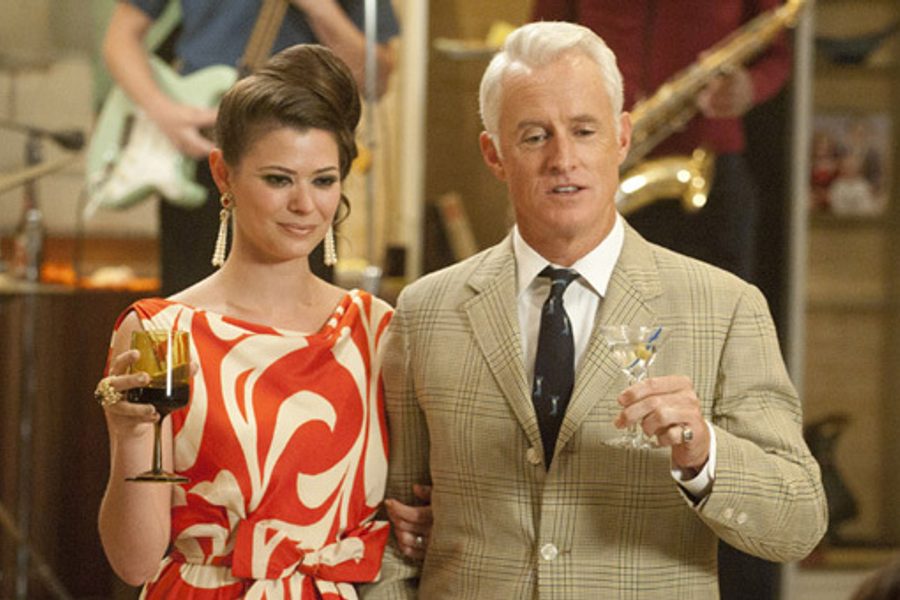Mad Men’s Maddening Decline
Season 5 gives fans what they crave. But the lack of subtlety is ruining the show.
Jude Ellison Sady Doyle

It’s hard to say exactly when I started to lose my patience with Mad Men. But I know exactly when I realized how frustrated I’ve become: It happened about halfway into “Far Away Places,” which aired on April 22. The day that shall live in infamy – The Day Roger Sterling Dropped Acid.
I’m probably alone in this. Roger’s LSD trip has been praised all over the Internet. But I couldn’t help thinking that, in years past, “Roger Sterling drops acid” has been the stuff of jokes, Internet speculation, and (one imagines) particularly unsubtle fan fiction. It’s always been something Mad Men might do, if it were a lesser show: Take Roger, who manages to seem exceptionally hedonistic even in a show about an ad agency staffed entirely by philandering day-drinkers, and give him the drug we most associate with the 1960s, thus clobbering the audience with two obvious messages. First: Roger sure likes to party! Which we knew. Second: This show is set in the sixties, a decade in which people took LSD. Which, one hopes, we also knew.
This is evidence of a worrying tendency in Mad Men’s fifth season. As Willa Paskin, writing at Salon, put it: “[Every] episode this season has contained at least one big, showy, bringing-down-the-house scene or talking point… What was previously subtext is now often text.” Those talking points are often scenes that fans have requested for years: Roger drops acid and dumps his trophy wife. Strong, glamorous Joan leaves the husband who raped her. Wormy Pete Campbell gets punched in the face. These moments are gratifying. But by providing such simple, broad-strokes gratification, they endanger the complexity and political insight that make the show great.
Mad Men’s premise is tricky: A story about the decay of white, male privilege, told largely from the perspective of heretofore-unchallenged white men. In order for the show to work, we had to empathize with those men enough to keep watching, but not so much that we excused them. If the balance tipped one way, it would be conservative propaganda: A show about how those rotten feminists and civil rights activists wrecked America. But if it tipped in the opposite direction, it would be Boomer mythology: Yet another show about how the groovy 1960s solved inequality, for everyone, forever.
Mad Men worked by exploiting that ambivalence, seducing us with nostalgia – the gorgeous costumes, the sexy secretaries, the men drinking scotch and chain-smoking during work hours – and repulsing us with its rotten core. Good-times Roger donned blackface; smoldering Don Draper alternately neglected and controlled his wife. This approach to injustice was radical, because it was realistic: People did awful things, and allowed awful things to happen, just because those awful things were common. In a bad society, Mad Men suggested, even good people will do bad things. That idea is uncomfortable. But it’s also the best argument for social change.
This gets lost when Mad Men starts providing wish fulfillment. Our natural tendency as viewers is to look for heroes. Mad Men indicted its era by frustrating that impulse; even the most likable or marginalized characters were sometimes appalling. But as it has become a more crowd-pleasing show, its sympathies have fallen, all too often, directly to the sexist, racist white guys.
It’s fun to watch Roger drop acid. But his anxieties about aging, and his desire to be free of the pretty young secretary he married in a moment of midlife crisis, aren’t uncommon for narcissistic, sexist jerks. Dressing them in symbolism (one side of Roger’s head is young, the other is old – get it?) doesn’t make them deep, and it doesn’t excuse the show for reducing his wife Jane to a greedy, hysterical caricature. It’s great to see Joan get free of Greg, her rapist husband. But to suggest that he’s especially unforgivable, on a show where most of the male characters – including Don himself – have been shown sexually harassing, assaulting or abusing women, is a bit hypocritical. It suggests that the problem with Greg isn’t that he raped a woman, but that he raped a fan favorite. (Contrast the liberated Joan with the infamous “fat Betty” storyline to get a sense of how the show treats abused women with smaller fan bases.)
When Sterling Cooper Draper Pryce hired its first black employee, it was news. But that employee – a secretary named Dawn – has been a largely silent excuse for white characters to feel self-conscious about their racism. The new hire Mad Men has focused on is Michael Ginsberg: A Jewish white man.
This isn’t to say we should abandon Mad Men. The show is rarely predictable; I’m losing patience, not hope. But in a quieter, less meme-worthy moment from last week, a client told Peggy to “stop giving me what I ask for, and give me what I want.” It’s a lesson the show would do well to learn. We asked for these show-stoppers. But Mad Men is best when it denies us the fun we ask for, and gives us the discomfort we need.
Jude Ellison Sady Doyle is an In These Times contributing writer. They are the author of Trainwreck: The Women We Love to Hate, Mock, and Fear… and Why (Melville House, 2016) and was the founder of the blog Tiger Beatdown. You can follow them on Twitter at @sadydoyle.







